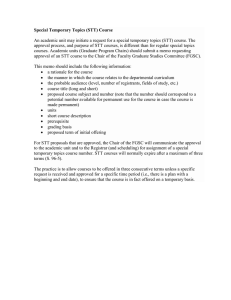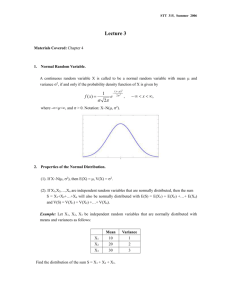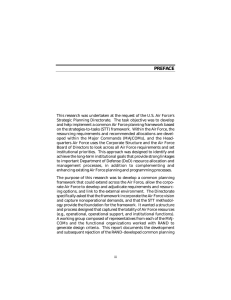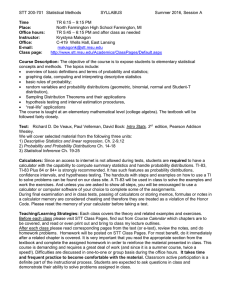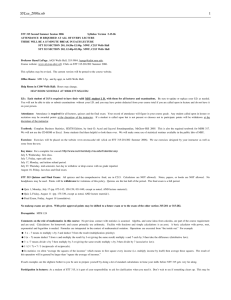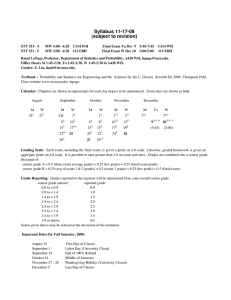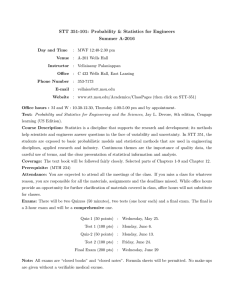Tracking Quantity Fluctuations using STT
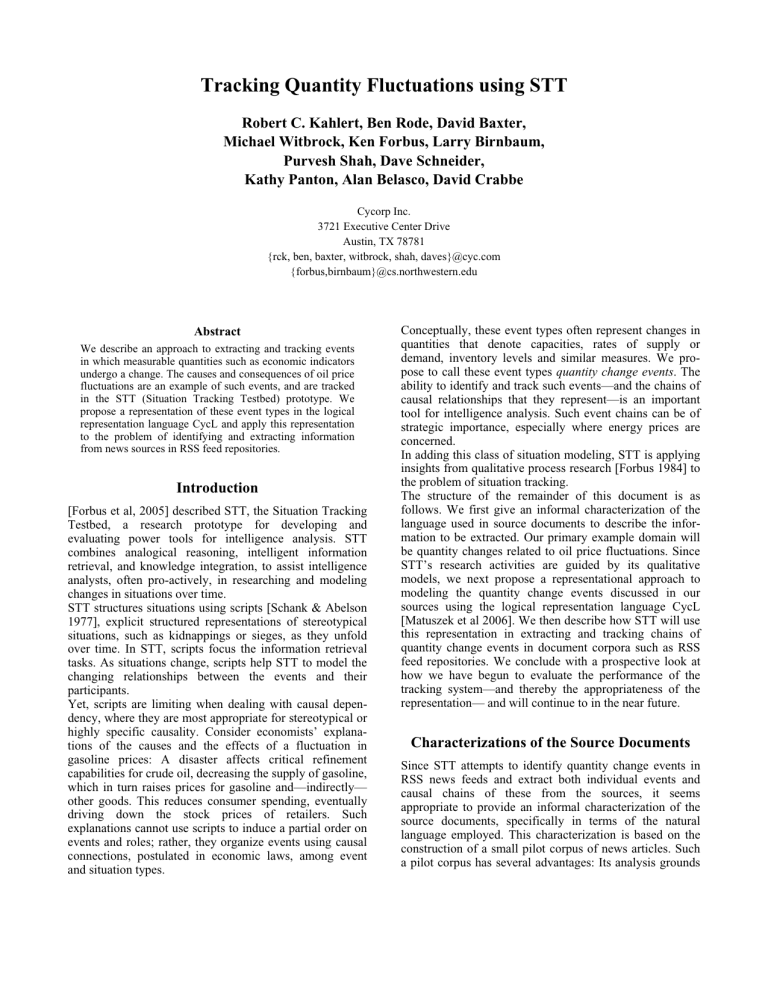
Tracking Quantity Fluctuations using STT
Robert C. Kahlert, Ben Rode, David Baxter,
Michael Witbrock, Ken Forbus, Larry Birnbaum,
Purvesh Shah, Dave Schneider,
Kathy Panton, Alan Belasco, David Crabbe
We describe an approach to extracting and tracking events in which measurable quantities such as economic indicators undergo a change. The causes and consequences of oil price fluctuations are an example of such events, and are tracked in the STT (Situation Tracking Testbed) prototype. We propose a representation of these event types in the logical representation language CycL and apply this representation to the problem of identifying and extracting information from news sources in RSS feed repositories.
[Forbus et al, 2005] described STT, the Situation Tracking
Testbed, a research prototype for developing and evaluating power tools for intelligence analysis. STT combines analogical reasoning, intelligent information retrieval, and knowledge integration, to assist intelligence analysts, often pro-actively, in researching and modeling changes in situations over time.
STT structures situations using scripts [Schank & Abelson
1977], explicit structured representations of stereotypical situations, such as kidnappings or sieges, as they unfold over time. In STT, scripts focus the information retrieval tasks. As situations change, scripts help STT to model the changing relationships between the events and their participants.
Abstract
Introduction
Cycorp Inc.
3721 Executive Center Drive
Austin, TX 78781
{rck, ben, baxter, witbrock, shah, daves}@cyc.com
{forbus,birnbaum}@cs.northwestern.edu
Yet, scripts are limiting when dealing with causal dependency, where they are most appropriate for stereotypical or highly specific causality. Consider economists’ explanations of the causes and the effects of a fluctuation in gasoline prices: A disaster affects critical refinement capabilities for crude oil, decreasing the supply of gasoline, which in turn raises prices for gasoline and—indirectly— other goods. This reduces consumer spending, eventually driving down the stock prices of retailers. Such explanations cannot use scripts to induce a partial order on events and roles; rather, they organize events using causal connections, postulated in economic laws, among event and situation types.
Conceptually, these event types often represent changes in quantities that denote capacities, rates of supply or demand, inventory levels and similar measures. We propose to call these event types quantity change events . The ability to identify and track such events—and the chains of causal relationships that they represent—is an important tool for intelligence analysis. Such event chains can be of strategic importance, especially where energy prices are concerned.
In adding this class of situation modeling, STT is applying insights from qualitative process research [Forbus 1984] to the problem of situation tracking.
The structure of the remainder of this document is as follows. We first give an informal characterization of the language used in source documents to describe the information to be extracted. Our primary example domain will be quantity changes related to oil price fluctuations. Since
STT’s research activities are guided by its qualitative models, we next propose a representational approach to modeling the quantity change events discussed in our sources using the logical representation language CycL
[Matuszek et al 2006]. We then describe how STT will use this representation in extracting and tracking chains of quantity change events in document corpora such as RSS feed repositories. We conclude with a prospective look at how we have begun to evaluate the performance of the tracking system—and thereby the appropriateness of the representation— and will continue to in the near future.
Characterizations of the Source Documents
Since STT attempts to identify quantity change events in
RSS news feeds and extract both individual events and causal chains of these from the sources, it seems appropriate to provide an informal characterization of the source documents, specifically in terms of the natural language employed. This characterization is based on the construction of a small pilot corpus of news articles. Such a pilot corpus has several advantages: Its analysis grounds
the design of an appropriate representational vocabulary
(described in the next section Representing Quantity
Change Events below) and identifies needed background knowledge. The corpus helps in suggesting and/or training
STT’s textual extraction patterns. Finally, it allows evaluating and monitoring the performance of STT in the identification of quantity change events as well as the extraction of chains of such events (see also the section
Assessing the Performance of STT below).
Changes in Oil Prices: The Example Domain
We chose changes in the price of crude oil as an example domain. Unsurprisingly, there is no shortage of articles on this subject, from which we selected some of the factors to which economists attribute oil price changes. Oil prices are driven by energy demand of economies, weather
(hurricanes, cold or mild winters), political issues (stability in OPEC members like Nigeria; foreign policy toward
OPEC members like Iran, Saudi Arabia, and Venezuela), inventory levels, infrastructure capacities, and the financial health of oil companies allowing them to sustain long-term
R&D and exploration. Some of these issues are related, e.g., instability in an OPEC member might cause oil companies operating there to decrease exploration.
Very often, the types of causal events cited in these cases are themselves changes in quantities, such as inventory levels, consumption rates, production rates, and similar.
Consequently, proper modeling of quantity change events and the representation of the laws stating dependencies between quantity changes plays an important role.
Pilot Corpus Construction
We selected 50 articles and short reports via the WWW from news agencies such as the BBC, CNN and oil Industry journals that discuss oil prices, oil exploration, and influences on oil demand and availability, within the time span of 2003-2006. We then hand-annotated the corpus to identify and classify the quantity change events reported.
The analysis revealed that 39 documents mentioned quantity change events in some form or another: oil supply levels, strategic natural gas reserves, production capabilities, rise in company stocks, etc.
Ten documents described oil related issues but mentioned no quantity change events; these articles were intended as distracters with apparently high relevance in an evaluation set. One document was a duplicate of another.
Of the over 200 quantity change events, 86 concerned changes in the trading of oil, and of these 20 were changes in oil futures and 66 changes in oil prices.
Extracting Quantity Change Events
While the language used in oil price change reporting is highly stylized, an impressive variety of verb-forms is used to liven up the market reporting: 20 verbs for increase events, 14 for decrease events. A host of additional phrases qualifies the price and relates it to prior trading situations
(for a fragment of a BNF grammar for matching just decreases in oil prices, see Figure 1 below).
Quantity change events of this kind are associated with a trading organization, such as ICE Futures London
(formerly International Petroleum Exchange) or the New
York Mercantile Exchange (NYMEX). Because of the strong tie these organizations have with specific cities, writers often use the city names as referential short-hands.
Consequently, a rise of the oil price in London is not to be read as a rise of the price paid by people in the Greater
London area, but as a rise of the price of oil futures
(typically, Brent crude) as traded on the ICE Futures exchange in London. Especially in the futures market, specific futures (so-called benchmarks) are associated with specific locales—for example, the West Texas Intermediate benchmark is traded at the US spot market in Cushing,
Oklahoma, while (North Sea) Brent crude is traded at ICE
Futures London. Thus, the name of the traded product provides a default trading location, allowing journalists to omit location information.
Unsurprisingly, date information in the articles is overwhelmingly relative to the date of the publication of the article. About a third of the articles have no date information at all, and half of the articles require knowing the current date to puzzle out references such as
“Monday”, “August 15”, or “the previous day”.
<decrease> ::= <decrease-verb> <decrease-change-qualifier> <amount> ;
<decrease-verb> ::= be down | drop | edge | fall [back] | follow a fall | lose
| plunge | retreat | shed | slip | slump | tumble;
<decrease-change-qualifier> ::= by [more than] <change-amount>
to [settle at | close at | just under]
| below | as low as | from <amount> to <amount> | more than;
<change_amount> ::= amount | percentage;
<percentage> ::= <float> % ;
<amount> ::= [ <currency> ] <float> [ <barrel-qualifier> ] [ <currency> ] ;
<currency> ::= US [$] | U.S. [$] | usd | cents ;
<barrel-qualifier> ::= per barrel | / bbl ;
Figure 1: Simplified over-accepting BNF grammar for extracting the amount part of oil price decrease events.
Special care has to be exercised when extracting information about futures, which come with additional date information: three fourths give the month and ten percent the day on which the futures are due.
Extracting Event Chains
So far our analysis of quantity change events has focused primarily on oil price change events. We are in the process of extending that hand-annotation and analysis of the pilot corpus to the events that precede the quantity change event in the causal chain. Consider for example the rise of the
Brent crude oil futures in London on February 19, 2006, as indirectly caused by the reduction of shipping of crude from the Nigeria delta—a quantity change event that was in turn caused by the shutdown of Royal Dutch Shell’s
Forcados oil terminal.
This chain of events consists of several quantity change events—the rise in the oil price as traded at the ICE
Futures in London, caused by the drop in global supply due to the reduction of shipments from one of the oil hubs of the Niger Delta. However, the last quantity change event, the reduction of shipment, is tied to a non-quantity change event, namely the closing of the Forcados oil terminal by
Shell. With this shut-down event, the event chain is effectively grounded.
Interestingly, preliminary analysis indicates that the interests of the readers go beyond the grounding non-quantity change event. All articles on the shutdown of the Forcados oil terminal report on the rebels living in the Nigerian
Delta, who, through their attacks, forced Shell’s hand in the shutdown.
For STT, this observation reveals an interesting dilemma: that extra level of detail, obviously appreciated by the readers, introduces an enormous degree of complexity in terms of the necessary capabilities for event representation, information extraction and natural language parsing.
Quantity change events as such are relatively straightforward to model and interpret; and the possible grounding events for limited domains appear to form a manageable class. But the background events that triggered the grounding event are semantically very unconstrained, and the capability to model and parse them all presents quite a challenge.
Representing Quantity Change Events
We now describe our representational approach to modeling quantity change events, the way these events could, in principle, chain together, and how these chains eventually bottom out in non-quantity change events.
The Representational Vocabulary
ResearchCYC is replete with predicates for specifying scalar quantities, e.g. priceChargedFor , a ternary predicate which relates a geographic location and a commodity type to a scalar value that is the price charged for instances of that commodity type in that region.
Predicates such as this have been ResearchCyc’s timehonored approach to tracking quantities, following e.g.
[Cohen et al., 1998]. Note two very important features.
First, these predicates are time-dependent, since prices may vary between time t and time t . Second, at point p and time t , priceChargedFor is functional in its scalar argument, mapping a location and a commodity type to at most one price. (Notice that the time range from t to t is not given as an explicit argument to the predicate, but represented in the temporal qualification of the context
[Lenat 1999].
These properties are sufficient to make predicates such as priceChargedFor appropriate building blocks for evaluatable parametric functions or fluents [McCarthy 1998].
CycL provides for a currying-function, Kappa, to derive lower-arity predicates from higher-arity predicates by fixing one or more of the argument positions. Here, Kappa is used to fix the commodity type argument of the predicate priceChargedFor –– to Petroleum-CrudeOil :
(Kappa (?REGION ?PRICE)
(priceChargedFor ?REGION
Petroleum-CrudeOil ?PRICE))
The function-denoting function, FunctionToArg allows us to convert this to a parametric function, which takes a geographic region for its argument, and, at a given time, returns the price of crude oil in that region:
(FunctionToArg 2
(Kappa (?REGION ?PRICE)
(priceChargedFor ?REGION
Petroleum-CrudeOil ?PRICE)))
A bit of syntactic sugar—declaring this to be the macro expansion of a new function PriceOfInRegionFn — allows us to express this parametric function so:
(PriceOfInRegionFn Petroleum-CrudeOil)
Such parametric functions are one key building block of the quantity change event vocabulary. Another one consists in collection-denoting functions, which, given a parametric function and a candidate argument for the function, return the class of events in which the value denoted by the function applied to the argument increases or decreases.
For example, ChangeInValueReturnedByFn takes as arguments a time-dependent function f , an argument to f and a scalar comparator, e.g. greaterThan
. It returns the class of events in which the values returned by the function
(when applied to the admitted argument) at start and end of the event, respectively, are related by the comparator.
Thus, the class of all events in which the price of crude oil in Bahrain, say, was strictly greater at the end than at the start can be precisely and compositionally represented by
(ChangeInValueReturnedByFn
(PriceOfInRegionFn Petroleum-CrudeOil)
Baharain greaterThan)
Rules of Inference for Quantity Change Events
The next part of the CycL infrastructure for reasoning about quantity change is a set of inference rules modeling economic laws which explain, for example, price changes in terms of changes in demand, supply, or inventory.
Relationships of direct and inverse proportionality can be defined between parametric functions thus, e.g. the inverse proportionality relationship between supply and demand can be captured as follows:
(implies
(genls ?PRODTYPE ConsumableProduct)
(inverselyProportional
(FunctionToArg 2 (Kappa (?AGT ?RATE)
(supplyRate ?AGT ?PRODTYPE ?RATE)))
(FunctionToArg 2 (Kappa (?AGT ?RATE)
(demandRate ?AGT ?PRODTYPE ?RATE))))
The knowledge about the inverse proportional relationship can then be used to interpret the relation between, the changes in the values returned by two functions that are inversely proportional as a relationship of cause between instances of the corresponding event types –
(implies
(and
(inverselyProportional ?FN1 ?FN2)
(isa ?CHANGE-EVENT
(ChangeInValueReturnedByFn
?FN1 ?ARG ?COMPARE))
(inverseBinaryPredicateOf
?COMPARE ?INVERSE-COMPARE))
(thereExists ?OTR-CHANGE-EVENT
(and
(causes-SitSit
?CHANGE-EVENT ?OTR-CHANGE-EVENT)
(isa ?OTR-CHANGE-EVENT
(ChangeInValueReturnedByFn
?FN2 ?ARG ?INVERSE-COMPARE))))
At current, the functional dependencies supporting quantity change reasoning in Cyc are to a certain extent ‘hand derived’ from economic explanations. However, in the long run, we plan to use qualitative process theory [Forbus,
1984] to express a common–sense theory of economics that can be used to automatically fill in intermediate causal events in explanations, since the causal chains mentioned in text are often partial. For example, a rule that states how price and supply vary inversely proportional with respect to each other could then be derived from a qualitative proportionality assertion like the following:
(implies
(genls ?PRODTYPE ConsumableProduct)
(qprop-
((QPQuantityFn price)
?AGT ?PRODTYPE)
((QPQuantityFn supplyRate)
?AGT ?PRODTYPE)
?PRODTYPE))
Grounding Quantity Change Events
The vocabulary described so far allows reasoning about economic rules that function at a high level of abstraction.
However, these laws are intended to correlate (and thereby explain) real-world events. Therefore, the vocabulary must also allow modeling the transition from the realm of economic theory into the specific event types that ground the event chain. The vocabulary must support relating localized or specialized quantity change event types to non-quantity change event types, Consider the following rule, which relates events in which the decreases in production rates of specific facilities are explained by events that cause these facilities to close. More formally, this rule states at the type level that possible triggers for decrease events in the production rate of a type of resource for a given region are events where the resource-relevant mineral fields of that region are shut down. When given a commodity type as an argument, the function-denoting function ProductionRateOfByFn returns a temporally parameterized unary function which, when applied to a region, denotes the regional rate of production of a type of commodity (for example, of petroleum crude oil).
SubcollectionOfWithRelationToFn is a type-denoting function which takes a type, a relation, and an individual as arguments and returns the subset of the type characterized by its instances having the given relation to the given individual.
(implies
(and
(isa ?FIELD MineralField)
(objectFoundInLocation ?FIELD ?REGION)
(naturalResourcesInRegion
?FIELD ?RESOURCE-TYPE))
(candidateTriggerSituationTypes
(ChangeInValueReturnedByFn
(ProductionRateOfByFn
?RESOURCE-TYPE)
?REGION lessThan))
(SubcollectionOfWithRelationToFn
ClosingAFacility objectActedOn
?FIELD))
By chaining functional dependencies until arrival at an event type for which candidate triggers are inferred, it is possible to identify causal triggers for a wide variety of quantity change events. This reasoning process complements the reasoning done by qualitative process theory [Forbus, 1984], since it concerns the preconditions and external events that perturb the network of causal relationships, as opposed to reasoning within the influences of the causal network itself.
From Grounding to Narrative Closure
While rules like the above example satisfy the modeling requirement of grounding the event chain in events that are themselves not quantity change events, the readers of the
RSS feeds are interested in more information than that. In the example of a reported facility shut-down, traders might
use such information to speculate, for example, about the duration of the production rate reduction. As an example, consider the following rule, which suggests that candidate trigger event types for the shutdown of facilities might be types of attacks upon those facilities.
(implies
(and
(genls ?CLOSING ClosingAFacility)
(isa ?FACTILTY Facility-Construct)
(implies
(isa ?INCIDENT ?CLOSING)
(objectActedOn ?INCIDENT ?FACILITY)))
(candidateTriggerSituationTypes ?CLOSING
(SubcollectionOfWithRelationToFn
AttackOnObject attackAgainst
?FACILITY)))
This suggests two things. For one, it highlights the importance of the existing script vocabulary available to STT, because the beginning of such a quantity change event sequence might require a script to be modeled. Furthermore, in terms of analyzing news sources, the event supporting the proximate causal event explaining the earliest quantity change event often suffices as the initial trigger in the explanation chain for human analysts.
Maintaining Geo-Temporal Soundness
This presentation of the vocabulary for representing and reasoning about quantity change events so far has glossed over the question of how STT ensures that the temporal and spatial indices of reasoning remain sound. One would not want to suggest a rise of gasoline prices in Germany as a cause for a drop in consumer spending in Brazil (without some additional arguments). Spatial indices in economic reasoning are tricky, because often the spatial proximity masks what is in reality a qualitative influence, which however need not be local at all. Thus, a drop in crude oil production in neighboring Canada may be as problematic for the United States as a decrease in production in South
American Venezuela, because both are exporters of crude oil to the US.
Equally, one would not want to suggest a rise in crude oil futures in March as a possible cause for a rise in gasoline prices in February (ever). Here, the events involved project temporal constraints onto the reasoning and the document search space that provide helpful pruning support.
In the long term, we hope to leverage ResearchCYC’s context space mechanism [Lenat 1999] widely, but that mechanism is, at present, most developed for temporal indices. We plan to address the issue of spatial context in more detail in the very near future.
Natural Language Representations
All of the representation for change events presented so far is tied to the natural language knowledge that STT has about English. The assertions that relate the representation to English lexical information are not used during reasoning about the situations, but are leveraged by the intelligent information extraction sub-systems of STT, for example, to generate appropriate information retrieval strings or to parse sections of the retrieved documents in order to extract quantity change event information.
Because of the compositional nature of natural language, there is some advantage to constructing the fluents in an equally compositional way, as this often simplifies the mapping between natural language and logical representation.
Such lexical information also includes many of the English syntactic patterns that are used when reporting causal chains in the news [Kuehne and Forbus, 2004].
Tracking Quantity Change Events
We now turn to the problem of extending STT, a system geared to leverage events structured by scripts, to handle quantity change events properly. This extension is an ongoing effort at the time of writing.
How STT performs Research
STT currently takes as an input a property of an event or situation that the analyst is interested in, e.g. the name of a person who was kidnapped. STT then uses background knowledge, i.e. information about the event type, the expected sub-events and other information provided by the script infrastructure to parameterize appropriate information extraction techniques. STT currently employs two techniques, the Brussel [Wagner et al 2006] system, a pattern matching text extractor, and ResearchCYC’s event learning prototype, which uses an example-based machine translation approach.
1
Each extraction approach builds up its own model of the situation, which STT currently reconciles using a voting scheme. The analyst is presented with the best resulting situation model.
Extending STT to handle Quantity Change Events
STT’s basic approach applies equally to quantity change events. Instead of generating document retrieval queries from the sub-event information of the script, STT will leverage the information about sequences of situation types that have the quantity change event type as a consequence.
STT will search for temporally prior sources that confirm that any of the suggested situation types happened. If such an event is an instance of a “script”-modeled event type,
STT will switch into “script mode” for its research as before. If the causative event is an instance of a quantity change event type, then the algorithm will be applied recursively to determine a cause for that event.
When reasoning about the potential causes of an individual quantity change event, such as a specific decrease in the price of crude oil to a value below US$58 per barrel on
1
This system is still undergoing active development; there is currently no publication citation for it.
February 15, 2006, STT could then proceed as follows:
First, STT determines quantity change event types that the individual event belongs to. Next, STT postulates the existence of an encompassing situation type, which represents the class of all situations whose outcomes include a quantity change event in which the crude oil price dropped. Finally, STT applies its rules of inference to determine possible sub-situation types, such as quantity change event types which might explain the price drop. In our example, STT might conclude that—among others— the quantity change event type that represents the class of all rises in total inventory of crude oil is an applicable subsituation type. This information is now available to STT for modeling and research purposes; for example, applied to intelligent information extraction this could result in the pro-active retrieval of the following text snippet:
Energy prices continued to fall February 15 [2006], with crude futures dropping below $58/bbl for the first time since November [2005] following another rise in US inventories. [OGJ 2006-02-16]
One of the distinguishing features of the STT system is its capability for tracking, i.e. monitoring information sources for news on events the analyst expressed interest in. Here, the quantity change event infrastructure is as helpful as the scripts are, because the inference rules suggest types of news feeds to expect.
Improving STT to handle Quantity Change Events
Some of the assumptions of the current STT implementation will have to be revisited. For example, quantity change events put a much higher premium on correctly identifying the time and space indices of the news article being analyzed. STT is already very adept at decoding temporal references that need to be interpreted with respect to the date of the article, but some additional work might be required.
The branching factor of the form of "textual abduction" as described here is a valid concern. However, we have already identified several strategies for aggressively bounding the factor. First, a lack of matching documents should in general help to prune incorrect connections.
Some care is necessary with this heuristic, since we also expect there to be many situations of skipped mediating quantity change events. News articles can leap from attributing an increase in consumer spending to a drop in oil prices, leaving out all mediating steps that relate the average consumer’s discretionary spending to the prices of products derived from crude oil. Here, a robust commonsense model of economics can help to puzzle out the implied mediating steps and construct a coherent model of the event chain.
It is in general the case that additional background knowledge can go a long way. For example, for a reduction in the global supply of oil, the OPEC member states make much better suspects for analysis than other states. If not for outright pruning, such considerations could at least be used to order the abductive expansion step, in the hope that more plausible scenarios will bottom out first and make other chains of reasoning unnecessary..
Finally, we hope to exploit the fact that many documents mention not one but two events and their link. Such cases could in the future assist the system in learning new connections, represented as the core for a new inference rule, between two event types STT is already familiar with.
Assessing the Performance of STT
We are currently developing metrics to assess the performance of STT in extracting individual and chains of quantity change events. Providing metrics is complicated by the fact that both IR components within STT, Brussel and the ResearchCYC event learner, are undergoing heavy redesign. Brussel is being retooled to employ the GATE
[Cunningham et al 2002] engine for its IE needs; the event learner team is augmenting the document index with geotemporal information, as well as experimenting with more aggressive document preprocessing, using a statistical POS tagger and disambiguation.
We hope to have separate metrics for each of the individual phases—quantity change event identification, document identification, event chain extraction—as well as for the end-to-end performance. The pilot corpus will serve as a baseline that we will extend continuously as STT gains proficiency.
Identifying Quantity Change Events
As described above in Characterization of Source
Documents , we have gathered 50 documents involving oilrelated matters for a pilot corpus. We split the corpus into
18 training and 29 validation documents and removed one duplicate. We annotated the corpus, identifying over 200 quantity change events, of which 87 were oil price or oil futures change events. This revealed that the training corpus contained half of all oil price change events (35 of
66), and the vast majority of the oil futures change events
(17 of 20). Next, we plan to train STT on the training set and evaluated its performance for precision and recall on both the training and the withheld validation document set.
Identifying Research Documents
As STT tries to elucidate the event chain leading up to a quantity change event, it will require a document corpus of articles upon which it can draw. In order to locate appropriate documents within that corpus, STT will need to both pre-process the corpus and generate appropriate search requests to the IR engine hosting the corpus.
We plan to evaluate the document identification along the dimensions of precision and recall by “hiding” our small pilot corpus in the 12,000 document corpus of RRS feeds that is part of the STT installation.
Event Chain Extraction
A further candidate metric we plan to gather is the length of the event chain reconstructed, with one metric for overall chain length and a second metric for how many mediating quantity change events skipped in a seed article
STT was able to fill in. This will require additional annotations on the pilot corpus to identify event chain lengths as well as the possibilities of cross-document chain reconstruction.
Tracking Background Knowledge Extension
As the pilot corpus grows and STT is enabled to handle the training identifications and extractions, the likelihood of encountering a completely novel situation should go down.
Specifically, the amount of background knowledge that must be added to understand a new article should decrease over time. For this reason, we tracked the background knowledge that had to be added to ResearchCYC in order to represent the training set portion of the pilot corpus. The knowledge breaks down into general background knowledge about quantity change events; knowledge needed to represent the use-cases from the pilot corpus; and natural language knowledge for both of these categories.
Overall, we introduced 71 new terms and stated 509 facts about them—for detailed metrics on the new terms introduced, see Table 1 below. The number of functions introduced reflects the representational choice of evaluatable parametric functions. In addition, we added
ResearchCYC, of which 101 fleshed out existing quantity change knowledge; 69 facts concerned information relevant for the use-cases; and 317 provided additional natural language information.
We plan to continue to do monitor these metrics as we grow the pilot corpus, expecting the number of new terms introduced to decline steadily.
Many exciting research issues remain. Some involve simply evaluating existing solutions to relevant aspects of the problem. Work on the analysis of argumentation, both economic [Riesbeck 1983] and political [Forbus and
Kuehne 2005], needs to be considered. Of especial concern here is to capture the respective influences—for example, between supply, price and demand—in such a way that no loops are introduced.
Then there are opportunities for exploiting the possible explanations that explicit models of qualitative process networks provide [Collins 1994] in order to suggest connections that no text is yet talking about. The latter approach should be most effective when coupled with analogical reasoning as a pruning function for pinpointing the most likely explanations. Both the acquisition of new triggering events and of the semantically open-ended background events might benefit from the use of cotraining techniques of bootstrapping [Blum & Mitchell
1998]. All of these efforts need to be canvassed for potential contributions, which if selected need to be positioned appropriately within STT’s framework.
Finally, one class of events that we have put aside for the moment which figures prominently in the oil price literature is innovation. Conceptually, an innovation is an engineering event that negates a background assumption, a potentially difficult representational operation (if it cannot be handled via restricting the temporal projection). This is especially tricky when innovative techniques, possibly involving new terminology for processes and equipment, are introduced, as the underlying knowledge base will either not have the lexical infrastructure to recognize the terminology or will be unclear as to where in its class hierarchies to position these new entities. Further research, most likely involving building stub terms using analogical reasoning, will be required.
Conclusion and Outlook
We described an approach to tracking quantity change events, such as the event chains triggered by oil price fluctuations, in the STT (Situation Tracking Testbed) prototype. We characterized the available source material, based on the analysis of a pilot corpus, introduced vocabulary appropriate to modeling that pilot corpus and described how STT will employ this representational infrastructure for research purposes.
Quantity Changes
Natural Language
Pilot Usecases
Totals
Terms Facts Terms Facts Terms Facts Terms Facts
— 19 — 5 — 2 7 20
10 45 5 64 2 21 18 137
17 131 15 111 7 103 32 195
Table 1: Metrics for the background knowledge needed to represent the use-cases in the pilot training corpus that introduced new terms. Because facts can involve multiple new terms, summing up the fact totals will count some facts twice. In the metrics presented here, 31 facts are mentioned twice, leaving 509 new facts.
References
Blum, A., Mitchell, T. 1998. Combining labeled and unlabeled data with co-training. In: COLT: Proceedings of the Workshop on Computational Learning Theory . Morgan
Kaufmann Publishers.
Cohen, P. Schrag, R. Jones, E. Pease, A. Lin, A. Starr, B.
Gunning, D. Burke, M. 1998. The DARPA High-
Performance Knowledge Bases Project , AI 1998, 19/4, pp.25-50.
Collins, J. W., 1994. Process-based diagnosis: An approach to understanding novel failures (Tech. Rep. No.
48). Evanston, Illinois: Northwestern University, The
Institute for the Learning Sciences.
Cunningham, H., Maynard, D., Bontcheva, K., Tablan, V.,
GATE: A Framework and Graphical Development
Environment for Robust NLP Tools and Applications.
in:
Proceedings of the 40th Anniversary Meeting of the
Association for Computational Linguistics (ACL'02) .
Philadelphia, July 2002.
Engelmore, R., and Morgan, A. eds. 1986. Blackboard Systems.
Reading, Mass.: Addison-Wesley.
Forbus, K. 1984. Qualitative process theory . Artificial
Intelligence, 24:85-168.
Forbus, K., Kuehne, S., 2005. Towards a qualitative model of everyday political reasoning . Proceedings of QR-05,
Graz, Austria.
Forbus, K., Birnbaum, L., Baker, J., Wagner, E., Witbrock,
M., 2005. Analogy, Intelligent IR, and Knowledge
Integration for Intelligence Analysis: Situation Tracking and the Whodunit problem , in: Proceedings of the 2005
International Conference on Intelligence Analysis ,
McLean, Virginia, May 2005.
Kuehne, S. and Forbus, K. 2004. Capturing QP-relevant information from natural language text.
Proceedings of
QR04.
Lenat, D. B. 1999, Dimensions of Context Space (available at http://www.cyc.com/doc/context-space.pdf).
Matuszek, C. Cabral, J., Witbrock, M., DeOliveira, J,
2006. An Introduction to the Syntax and Content of CYC, in: Proceedings of the 2006 AAAI Spring Symposium on
Formalizing and Compiling Background Knowledge and
Its Applications to Knowledge Representation and
Question Answering , Stanford, CA, March 2006.
McCarthy, J, Hayes, P., Some philosophical Problems , in:
Lifschitz, V,m (ed), Formalizing Common Sense , Exeter
(Intellect) 1998, p.21-63.
Rickel, J. and Porter, B. 1994. Automated modeling for answering prediction questions: selecting the time scale and system boundary , pp. 1191-1198. Proc. AAAI-94.
Riesbeck, C. K. 1983. Knowledge reorganization and reasoning style . Technical Report YALEU/DCS/RR 270,
Yale University, June 1983.
Schank, R., Abelson, R. 1977. Scripts, plans, goals, and understanding: An inquiry into human knowledge structures. Hillsdale, NJ: Lawrence Erlbaum.
Wagner, E., Liu, J., Birnbaum, L., Forbus, K., and Baker,
J., 2006. Using Explicit Semantic Models to Track
Situations across News Articles , to appear in: Proceedings of the 2006 AAAI Workshop on Event Extraction, Boston,
MA.
( no authors ), Oil and Gas Journal , February 16, 2006, accessed via http://ogj.pennnet.com/articles/article_display.cfm?Section
=ONART&C=GenIn&ARTICLE_ID=248280&p=7
